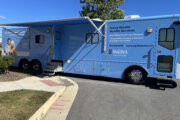What’s one thing you can’t live without at the gym? Odds are, headphones rank pretty high up on your list. For many people, a fitness tracker such as a Fitbit or Jawbone would be up there as well. And if you fall into the category that can’t live without either, there’s good news — the next generation of fitness trackers combine the best of both.
These new types of wearables, dubbed “hearables,” promise to offer more accurate measurements, longer battery life and a host of other benefits over wrist-worn fitness trackers. Hearables might be the next big thing, according to Scott Snyder, a senior fellow with the University of Pennsylvania’s Mack Institute for Innovation Management and president and co-founder of the mobile strategy company Mobiquity. “Research suggests that 55 percent of Americans plan to use a wearable device in the coming year,” Snyder says. “Most of the attention to-date has been on the wrist, with a barrage of new devices from wrist-worn trackers to sensorized smartwatches, but hearables are makings strides and leveraging a mainstream consumer accessory — the earbud.”
Earlier this year, LG Electronics launched its first hearable, the Heart Rate earphone, which measures (you guessed it) your heart rate, speed, steps and calories, plus provides audio feedback on your workout. Another hearable, The Dash, which is a combination of a Bluetooth headset, music player and waterproof fitness tracker, raised more than $3 million on Kickstarter — a sign that there’s a substantial market for these products.
[Read: What Is Everybody Wearing? Fitness Tech Gadgets!]
So why the ear? It turns out that tracking your vitals through the ear just makes sense, Snyder says. “The ear happens to be a good place to pick up blood flow as it moves consistently in and out of the ear, and the membrane is relatively thin,” he says. “We can pick up heart rate, blood flow and even oxygen levels at an accuracy rate comparable to the chest strap.”
Hearables also have the added benefit of fitting seamlessly into your routine, says Steven LeBoeuf, president and co-founder of Valencell, a research and design company focused on sensors and technology. “If I’m going to the gym and I forget my fitness tracker, it’s no big deal,” he says. “If I forget my headphones, I’ll turn around and head home to pick them up.”
Plus, with hearables, you don’t have to worry as much about battery life, since many can be charged right through your phone’s headphone jack, LeBoeuf says. Having to take off your tracker to charge it is a big reason people stop using it. “When people take off the wrist tracker to charge it, many never put it back on,” he says.
[Read: Making the Most of Your Fitbit.]
The one downside to hearables is that you won’t be able to capture data as often as you can with wrist-worn trackers, says Joshua New, a policy analyst with the Center for Data Innovation. “The hearable form factor is a double-edged sword in this sense,” he says. “Wristbands benefit from their potential to be always-on, in that they can collect biometric data while you sleep, run, swim, go on a date or sit in a meeting. Wearing headphones is not always viable in these situations.”
Despite the limitation, it’s only a matter of time until these products become mainstream, Snyder says, and the company he believes is best poised to take advantage of this market is Apple. “It seems like Apple has a huge opportunity to grab this category and tap into its newly acquired Beats product line — where they could offer music from the watch or iPhone and earbuds to capture health information and store in HealthKit for tracking and management,” he says. (HealthKit is an app for iPhones that acts as a hub for fitness apps and displays all collected information in one place.)
[Read: How Apple is Bringing Health Care to Your Smartphone.]
New sees the future of the market as a little more cloudy, and says it still remains to be seen what consumers look for in these products. “We’ll see how the market shapes up for these devices,” he says. “It’s not yet clear whether consumers will buy headphones because they are smart or because of other features like the quality of the sound, weight and whether they stay in place while exercising.”
But even if they don’t become the most widely used type of wearable, hearables allow the people who do use them to collect data on their health habits, and anything that does that has the potential to be beneficial, New says. “There are many different form factors for wearables — eyewear, watches, even smart onesies for babies and smart collars for dogs,” he says. “By making these wearable devices more adoptable, we will see more data being collected, and this is always a good thing.”
Editor’s Note: The author backed The Dash Kickstarter campaign.
More from U.S. News
How to Know if You’re Exercising Too Much
8 Health Technologies to Watch For
Are ‘Hearables’ the Next Big Thing in Fitness? originally appeared on usnews.com







